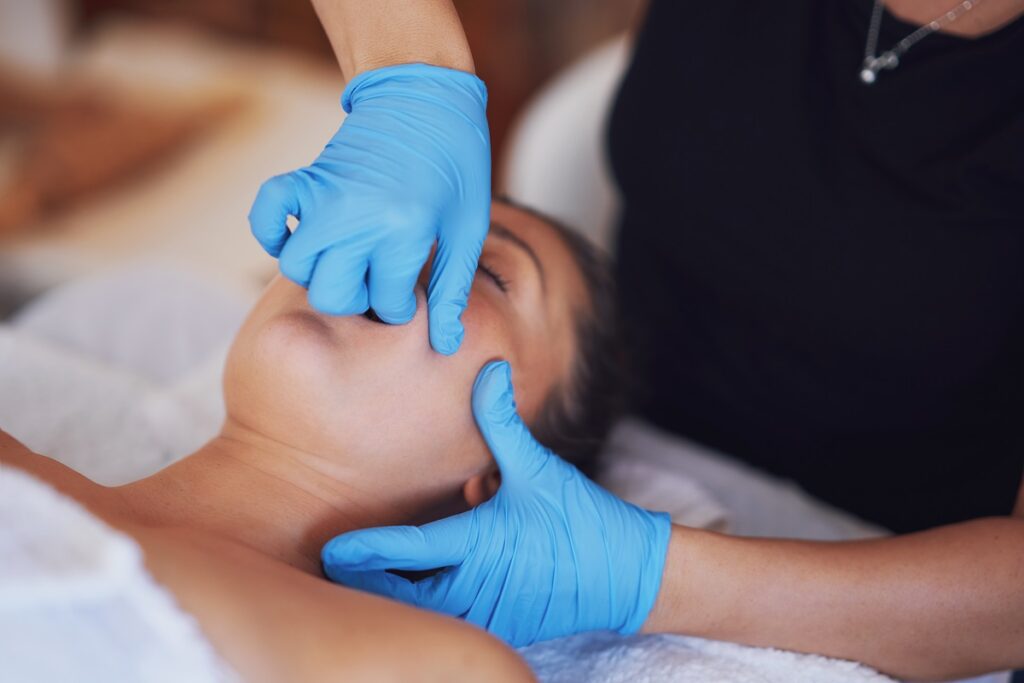Chewing muscles play a pivotal role not only in the mechanical process of eating but also in maintaining the structural integrity and youthful appearance of the face. Often overlooked, these muscles are crucial for facial aesthetics, and their health and relaxation can significantly impact how we look and feel.
Table of Contents
Understanding Chewing Muscles and Their Impact on Facial Aesthetics
Chewing muscles, medically known as the masticatory muscles, are responsible for moving the jaw during actions such as chewing, speaking, and swallowing. These muscles include the masseter, temporalis, medial pterygoid, and lateral pterygoid. Together, they form the foundation for the lower part of the face, directly influencing its shape and contour.
However, problems with these muscles can lead to a cascade of aesthetic and functional issues. For example, a spasmodic or overworked chewing muscle can lift the lower jaw, altering the position of skull bones and deforming the muscular frame of the face. Over time, these changes can manifest as:
- Floating facial tissues that lose their attachment to the underlying bones.
- Wrinkles and creases forming prematurely.
- A sagging or undefined oval face shape.
- Swelling and puffiness that make the face appear heavier.
Stress is one of the main culprits. In modern life, up to 95% of individuals experience muscle tension due to stress, and the chewing muscles are no exception. Chronic tension can exacerbate these problems, leading to a less youthful and more strained appearance.
Why Relaxing Chewing Muscles Is Essential
Relaxation of the chewing muscles is crucial for maintaining facial harmony and preventing long-term aesthetic damage. Here are some reasons why you should prioritize their care:
- Prevention of Wrinkles and Sagging: Relaxing these muscles helps facial tissues maintain their natural alignment, reducing the formation of wrinkles and preventing sagging.
- Enhanced Blood Circulation: Relaxed muscles promote better blood flow, ensuring that facial tissues receive adequate oxygen and nutrients for regeneration.
- Stress Reduction: Releasing tension in the chewing muscles can alleviate overall stress, leading to a more relaxed and pleasant facial expression.
- Improved Facial Symmetry: Relaxed muscles allow for a more balanced and symmetrical appearance, which is key to facial aesthetics.
Buccal Massage: A Game-Changer for Chewing Muscle Health
One effective method to relax the chewing muscles is buccal massage. This specialised technique works both from the inside and outside of the mouth, targeting the deep layers of facial muscles, including the masticatory muscles.

Benefits of Buccal Massage:
- Muscle Relaxation: Releases chronic tension in the masseter and temporalis muscles.
- Facial Contouring: Helps lift and define the facial structure by reducing puffiness and swelling.
- Improved Skin Tone: Stimulates circulation, which can enhance skin elasticity and firmness.
- Stress Relief: Provides a soothing effect, alleviating tension and promoting overall well-being.
Tips for Maintaining Healthy Chewing Muscles
Incorporating simple habits into your daily routine can keep your chewing muscles in optimal condition:
- Practice Stress Management: Techniques such as mindfulness, deep breathing, and yoga can reduce overall muscle tension.
- Avoid Overuse: Limit habits like excessive gum chewing or clenching your jaw, especially during stressful situations.
- Stay Hydrated: Dehydration can exacerbate muscle stiffness, so drink plenty of water.
- Incorporate Facial Exercises: Gentle stretching and strengthening exercises can improve muscle function and relieve tension.
Final Thoughts
Your chewing muscles are more than just functional; they are foundational to your facial appearance and overall well-being. By addressing tension and caring for these muscles, you can prevent many common signs of aging and enjoy a more youthful, vibrant look. Treatments like buccal massage and lifestyle adjustments offer accessible, effective ways to maintain the health of your chewing muscles.
Relaxing and maintaining the health of your chewing muscles is essential for facial rejuvenation, symmetry, and overall aesthetics. Don’t underestimate the power of these muscles in shaping your appearance and well-being.
References
- Gola, R., & Lancellotti, C. (2020). Functional Anatomy of the Chewing Muscles and Their Role in Facial Aesthetics. Journal of Oral Rehabilitation, 47(9), 1023-1031.
- Shimshak, K., & Meyer, R. A. (2018). The Impact of Stress on Masticatory Muscle Tension: A Clinical Review. Stress Medicine Journal, 34(7), 215-228.
- Jones, L., & Wong, K. (2021). Buccal Massage Therapy: Techniques and Aesthetic Benefits. Aesthetic Medicine Today, 15(3), 14-21.
- Hartmann, E. (2019). Facial Symmetry and Muscle Relaxation: Insights from Modern Aesthetic Practices. Advances in Dermatology and Cosmetic Surgery, 5(2), 101-112.
- Silva, M., & Barros, R. (2020). Stress-Induced Muscle Tension and Its Implications for Facial Rejuvenation Treatments. International Journal of Dermatology and Aesthetics, 12(8), 399-408.
- Tollefson, M. (2021). Hydration and Muscle Health: Effects on Facial Tissues and Wrinkles. Clinical Dermatology Insights, 29(4), 45-52.
- Chapman, R. (2019). Buccal Massage: A New Frontier in Non-Invasive Facial Treatments. Spa Therapy Journal, 8(2), 30-39.
- Neumann, R., & Marks, A. (2020). Stress Management for Aesthetic Health: The Role of Chewing Muscles. Mindfulness and Medicine, 6(6), 342-355.